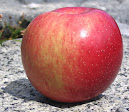LOVE THE ONES YOU'RE WITH

|
Lemonade, above, is a right good apple, well balanced and eminently worth choosing.
But the main reason I was glad to see this variety last month is geographic. My Lemonades grew in New Zealand and were picked in the spring.
They are half a year fresher than the other apples in stores today. And, you can taste it.
Usually by now the southern hemisphere has showered us with its spring harvest.
This comprises many familiar varieties that are all worth choosing over their older, tired northern clones.
This year the choices seem to be particularly impoverished, though it feels churlish to complain when we have any apples at all.
Now that it is officially summer—and, happy solstice!—what did you eat this spring?
I've fallen back on some old stalwarts, but there have been some surprises too.
Koru has been licensed here in the U.S., and this is the first year that the crop has made it into markets in the Boston area.
What's especially nice about Koru is that it does not stint on flavor. At peak that includes touches of orange and vanilla.
Koru lost a little of its edge in storage, but just a little.
 For many, this sturdy standard, light and crisp, seems to embody the ideal
apple of the pre-Honeycrisp era.
For many, this sturdy standard, light and crisp, seems to embody the ideal
apple of the pre-Honeycrisp era.
Fuji holds up well, but falls short (in my view) on flavor.
 Jazz is one of
my favorite of the industrial apples. When very fresh, which mine were not,
they can be quite
sharp and also hard.
Jazz is one of
my favorite of the industrial apples. When very fresh, which mine were not,
they can be quite
sharp and also hard.More typically they are crunchy, well balanced, and flavorful.
The quality of the Jazz apples that I found this spring varied a good deal. The ones I used this spring for my comparison with Koru were not the best.
They were not plentiful over the winter, and I rarely find any for sale after March, if they hang on that late.
Were my April apples anything like this wonderful variety at September peak?
Not remotely, but they evoked that happy state and I was pleased to have them.
Rockit is another new apple from New Zealand, also licensed now in the States.
It takes years for young trees to establish themselves and bear in quantity.
Thus, new varieties like Rockit and Koru eventually bear enough apples to sell though the wholesale market, typically providing more and more over time.
Rockit was in pretty good shape. with some nice flavors, but lacked the distinctive carrot and clove I noted when I sampled these in September of 2015.
 This crisp sturdy variety eats like a milder McIntosh. Half
McIntosh
it is, tempered by its other parent,
Delicious.
This crisp sturdy variety eats like a milder McIntosh. Half
McIntosh
it is, tempered by its other parent,
Delicious.Like my late Macouns above, Empire for me evokes the more-complex vinous delights available in the high season.
Empire bears up well in storage. I often turn to it in the late spring and into the summer.
Which is but three months away.

|
I hope that Rainier Fruit, which grows these, has not given up on conditioning them for spring consumption.
They are really outstanding at that time, when there is very little competition, and they are so welcome.
The supplies of all these varieties, whether from this hemisphere or the other, have surely been constricted and affected by the global coronavirus pandemic.
What have you been eating this spring?





Comments
Post a Comment
Join the conversation! We'd love to know what you think.